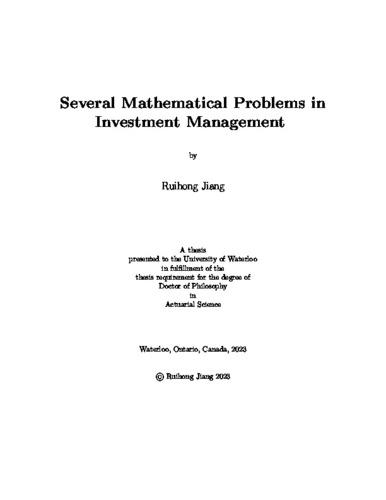| dc.contributor.author | Jiang, Ruihong | |
| dc.date.accessioned | 2023-08-21 17:53:47 (GMT) | |
| dc.date.available | 2023-08-21 17:53:47 (GMT) | |
| dc.date.issued | 2023-08-21 | |
| dc.date.submitted | 2023-08-16 | |
| dc.identifier.uri | http://hdl.handle.net/10012/19728 | |
| dc.description.abstract | This thesis studies four mathematical problems in investment management. All four problems arise from practical challenges and are data-driven.
Chapter 2 investigates the Kelly portfolio strategy. The full Kelly strategy's deficiency in the face of estimation errors in practice can be mitigated by fractional or shrinkage Kelly strategies. This chapter provides an alternative, the RL Kelly strategy, based on a reinforcement learning (RL) framework. RL algorithms are developed for the practical implementation of the RL Kelly strategy. Extensive simulation studies are conducted, and the results confirm the superior performance of the RL Kelly strategies.
In Chapter 3, we study the discrete-time mean-variance problem under an RL framework. The continuous-time problem was theoretically studied by the existing literature but was subject to a discretization error in implementations. We compare our discrete-time model with the continuous-time model in terms of theoretical results and numerical performance. In a daily trading market setting, we find both discrete-time and continuous-time models achieve comparable performance. However, the discrete-time model outperforms better than the continuous-time model when the trading is less frequent. Our discrete-time model is not subject to the discretization error.
Chapter 4 explores the valuation problem of large variable annuity (VA) portfolios. A computationally appealing methodology for the valuation of large VA portfolios is a metamodelling framework that evaluates a small set of representative contracts, fits a predictive model based on these computed values, and then extrapolates the model to estimate the values of the remaining contracts. This chapter proposes a new two-phase procedure for selecting representative contracts. The representatives from the first phase are determined using contract attributes as in existing metamodelling approaches, but those in the second phase are chosen by utilizing the information contained in the values of the representatives from the first phase. Two numerical studies confirm that our two-phase selection procedure improves upon conventional approaches from the existing literature.
Chapter 5 focuses on the capture ratio which is a widely-used investment performance measure. We study the statistical problem of estimating the capture ratio based on a finite number of observations of a fund's returns. We derive the asymptotic distribution of the estimator, and use it for testing whether one fund has a capture ratio that is statistically significantly higher than another. We also perform hypothesis tests with real-world hedge fund data. Our analysis raises concerns regarding the models and sample sizes used for estimating capture ratios in practice. | en |
| dc.language.iso | en | en |
| dc.publisher | University of Waterloo | en |
| dc.title | Several Mathematical Problems in Investment Management | en |
| dc.type | Doctoral Thesis | en |
| dc.pending | false | |
| uws-etd.degree.department | Statistics and Actuarial Science | en |
| uws-etd.degree.discipline | Actuarial Science | en |
| uws-etd.degree.grantor | University of Waterloo | en |
| uws-etd.degree | Doctor of Philosophy | en |
| uws-etd.embargo.terms | 0 | en |
| uws.contributor.advisor | Weng, Chengguo | |
| uws.contributor.advisor | Saunders, David | |
| uws.contributor.affiliation1 | Faculty of Mathematics | en |
| uws.published.city | Waterloo | en |
| uws.published.country | Canada | en |
| uws.published.province | Ontario | en |
| uws.typeOfResource | Text | en |
| uws.peerReviewStatus | Unreviewed | en |
| uws.scholarLevel | Graduate | en |

